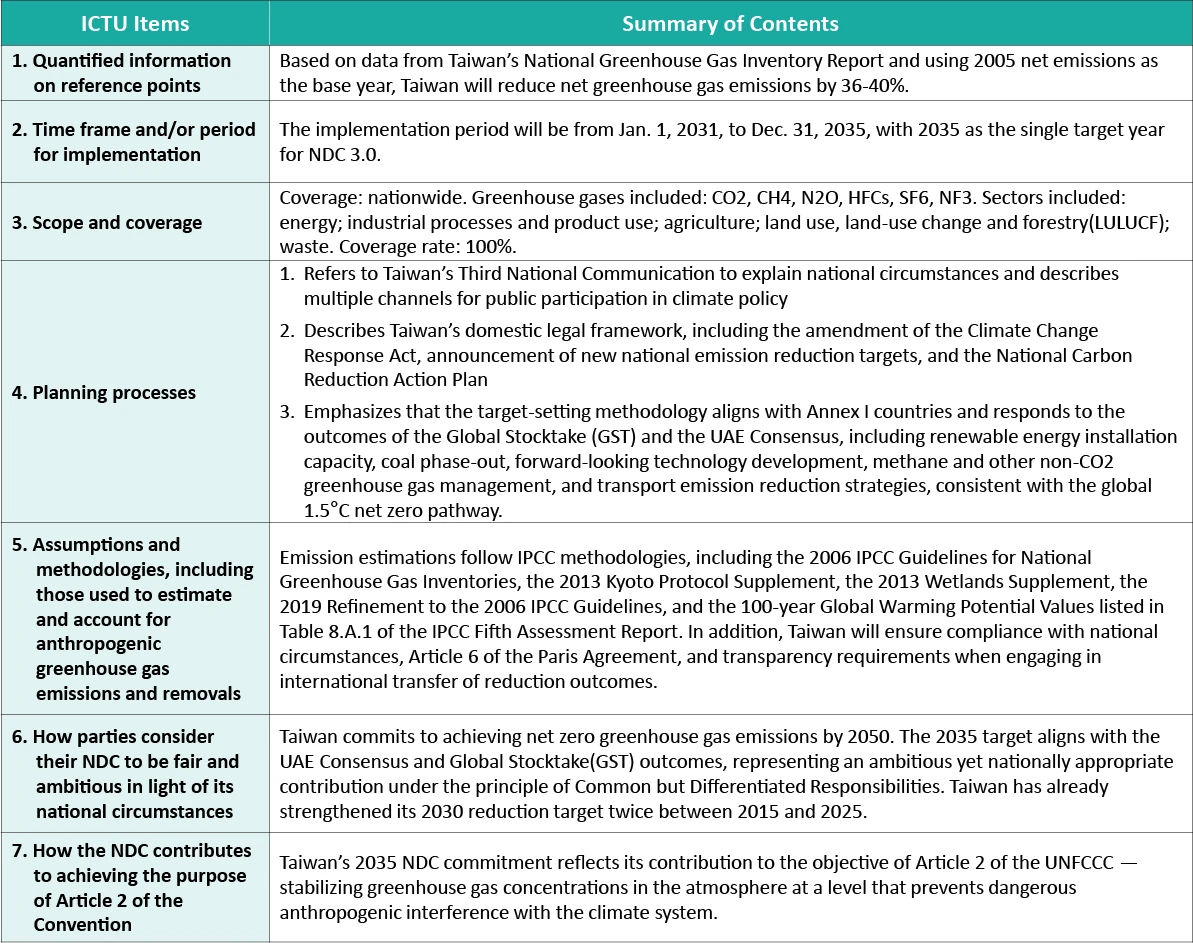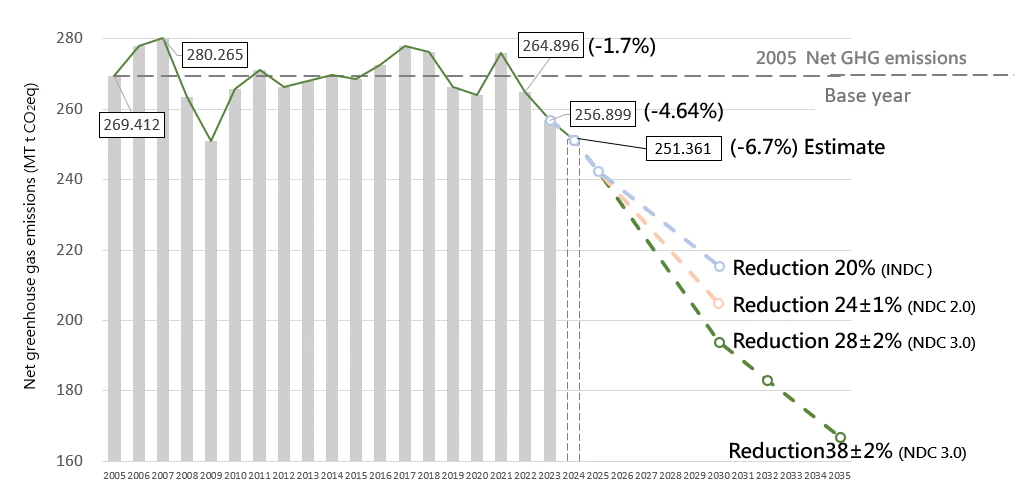Nationally Determined Contribution (NDC 3.0)
2035 Nationally Determined Contribution (NDC 3.0), the Republic of China (Taiwan)
Nationally Determined Contributions (NDCs) are a core mechanism established under the United Nations Framework Convention on Climate Change (UNFCCC) through the Paris Agreement adopted at the 21st session of the Conference of the Parties (COP21) in 2015. The Paris Agreement, for the first time, required all parties to put forward concrete, national-level climate action commitments in accordance with the principle of Common but Differentiated Responsibilities and Respective Capabilities (CBDR-RC), with the aim of holding the increase in the global average temperature well below 2°C above pre-industrialization levels and pursuing efforts to limit the temperature increase within 1.5°C. The Paris Agreement also established a five-year “Ambition Cycle,” requiring all parties to regularly update and enhance the reduction level, scope, and implementation transparency of their NDCs.
In line with Decision 1/CP.20 of the UNFCCC, Taiwan submitted its Intended Nationally Determined Contribution (INDC) in 2015, outlining a carbon reduction pathway consistent with the 2°C target of the Paris Agreement. In 2023, following Decision 1/CMA.3 of the Conference of the Parties serving as the meeting of the Parties to the Paris Agreement (CMA), Taiwan updated its NDC and amended the Climate Change Response Act to incorporate the goal of net zero emissions by 2050.
Based on Article 4, paragraph 8 of the Paris Agreement and in reference to Decisions 4/CMA.1, 1/CMA.3, and 1/CMA.5 adopted by the CMA, Taiwan submitted its clear, transparent, and comprehensible 2035 NDC in 2025, adopting the ICTU format accompanied by ten concise explanatory notes while launching social communication to establish concrete milestones for Taiwan’s low-carbon transformation.


- 1. Fairness and ambition
In line with the Paris Agreement, Taiwan has strengthened its reduction ambition, progressing from the initial target of reducing emissions by 50% compared to the Business-as-Usual (BAU) level in 2030 (-20% from 2005 levels), to a voluntary update in 2022 of a -23-25% target. In 2023, Taiwan legally established the 2050 net zero goal and instituted five-year phased regulatory cycles. Through inter-ministerial coordination, the Presidential Office’s National Climate Change Committee set new targets: a 26%-30% reduction by 2030 and 36%-40% reduction by 2035, along with 20 flagship carbon reduction actions and six major systemic innovations.
- 2. Domestic legislation and governance
The Climate Change Response Act grants legal status to the 2050 net zero target, strengthening ministerial division of responsibilities, carbon fee mechanisms, adaptation measures, information disclosure, and public participation. The National Council for Sustainable Development and local governments jointly implement central-local governance mechanisms. All ministries are required to submit periodic mitigation and adaptation action plans. Relevant laws governing energy, industry, land use, and construction are also under review to align with net zero transition. - 3. Energy transition and smart green energy strategy
Since 2016, the share of renewable energy has grown from 4.8% to 11.7% in 2024. The second phase of energy transition is driven by five pillars: diversified green energy, deep energy conservation, technological energy storage, resilient grids, and power decarbonization. The strategies strengthen the application of hydrogen energy, biomass energy, geothermal energy, and CCUS (carbon capture, utilization, and storage), creating a low-carbon, secure, and intelligent energy structure. - 4. Dual transformation in digital and green industries
Hydrogen, deep geothermal, and hybrid marine energy are being advanced, while AIoT is integrated to improve process energy efficiency and green manufacturing. The initiative promotes green factories and net zero infrastructure, accelerates agricultural carbon sinks, paddy field emission reduction, and electrification of agricultural machinery, while enhancing demonstration sites and technology deployment. - 5. Green finance and carbon pricing
A green and transition finance action plan has been announced, incorporating a sustainable taxonomy, green bonds, and a NT$10 billion Green Growth Fund to attract private investment. In 2025, a carbon fee mechanism is launched, and the Emissions Trading System (ETS) is prepared with a cap-and-trade framework, forming a comprehensive carbon pricing system aligned with international standards. - 6. Net zero sustainable green living and community drive
Green living and low carbon choices are promoted across all aspects of daily life including food, clothing, housing, transportation, education, and culture through action guidelines. Local communities are encouraged to develop energy autonomy and circular economies, fostering regional net zero ecosystems and civic participation platforms. - 7. Just transition and green talent development
A just transition mechanism is being established to ensure the participation of industries, workers, vulnerable groups, and Indigenous peoples, with transparent disclosure of progress and outcomes. The “Green Talent Cultivation Program” has been launched to enhance skills training, job-matching platforms, and transition employment support, while incorporating global talents. - 8. International cooperation
Taiwan engages in multilateral and bilateral collaborations and participates in the Article 6 ITMOs mechanism under the Paris Agreement. The Taiwan Carbon Solution Exchange is established, emphasizing the prevention of double counting and the pursuit of sustainable development. Through energy and carbon cooperation, climate finance, and technology partnerships, Taiwan contributes to global carbon reduction efforts. - 9. Climate change adaptation
Based on IPCC reports, Taiwan conducts periodic national climate risk assessments and formulates four-year “Adaptation Action Plans” covering infrastructure, water resources, coastal zones, agriculture, biodiversity, and public health, thereby strengthening nationwide adaptive resilience. - 10. Human rights, gender equality, and youth
Climate and human rights are incorporated into national action plans to ensure inclusion and decision-making justice for vulnerable groups. Gender equality policies are integrated into climate mitigation and adaptation measures. Youth policies emphasize education, communication, and participatory mechanisms to realize intergenerational justice, diversity, and inclusiveness.
- Data Source: Climate Change Administration
- Publish Date:2025-11-10
- Update Date: 2025-11-12
